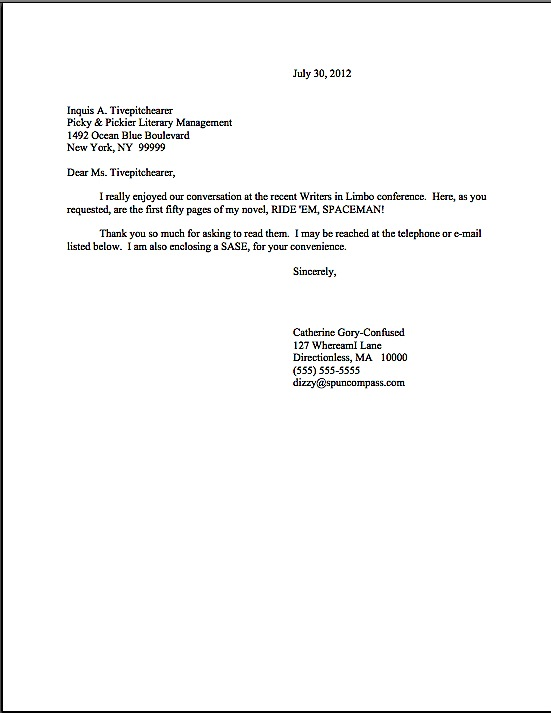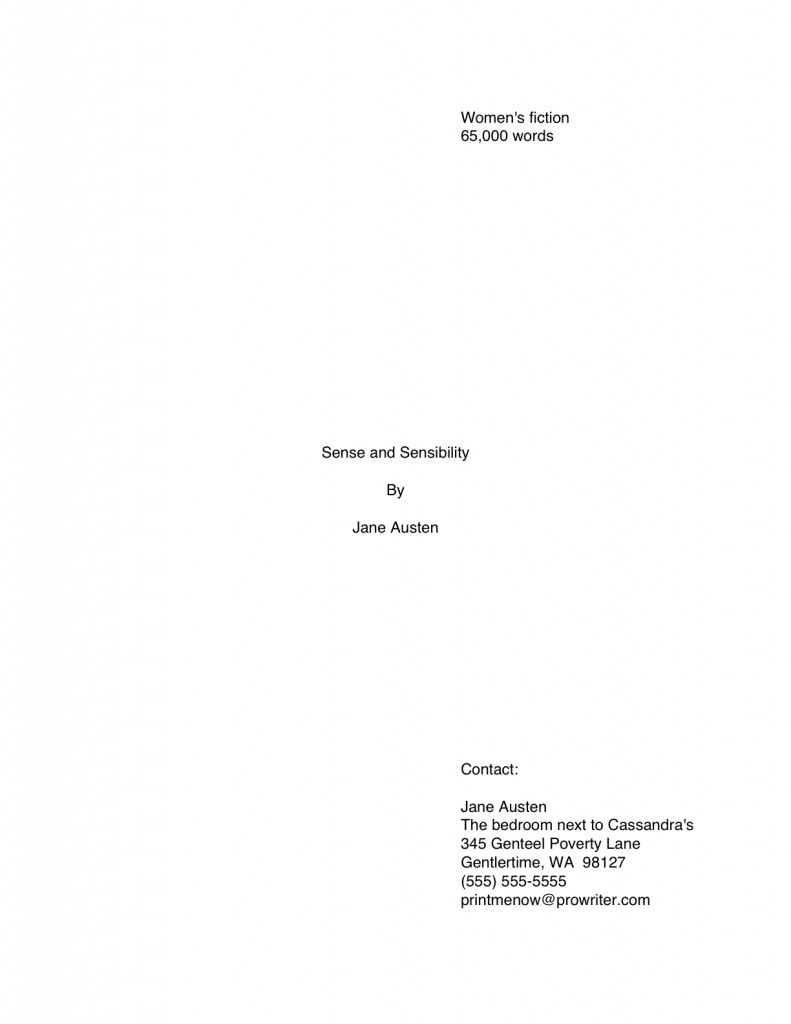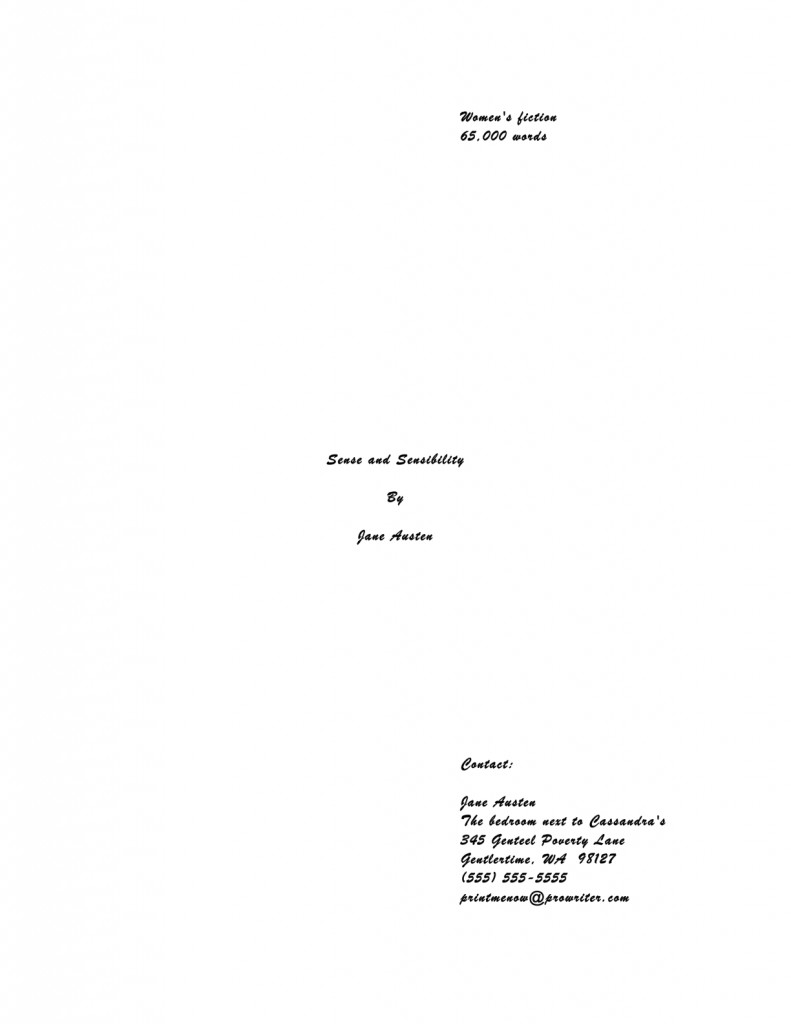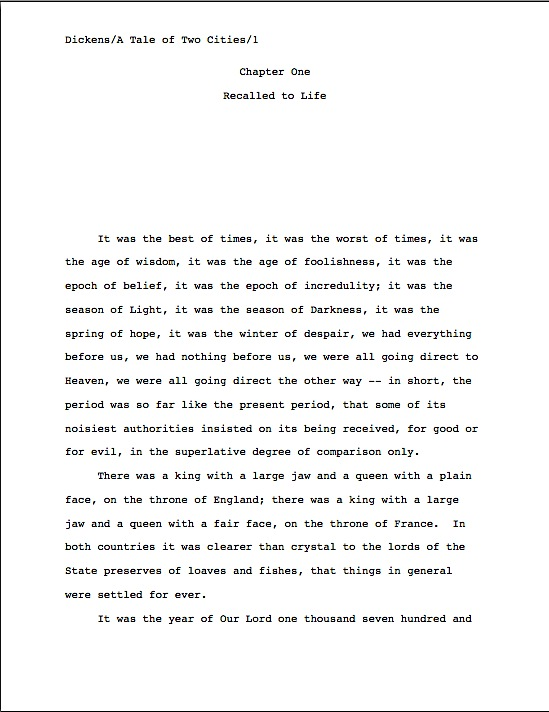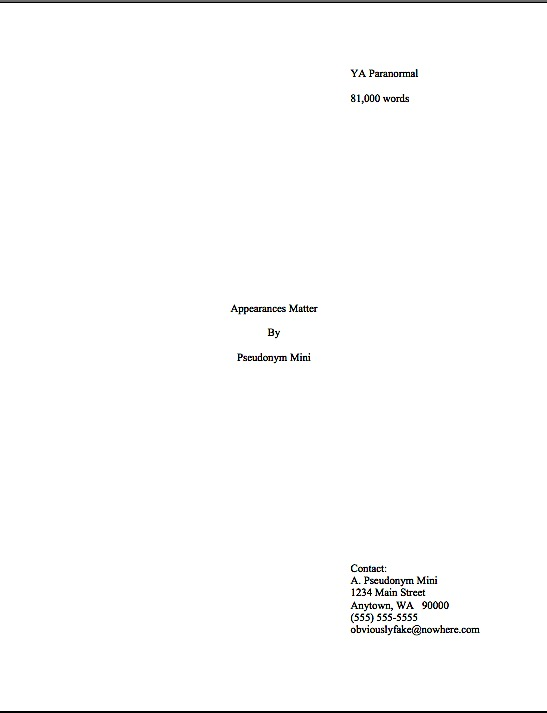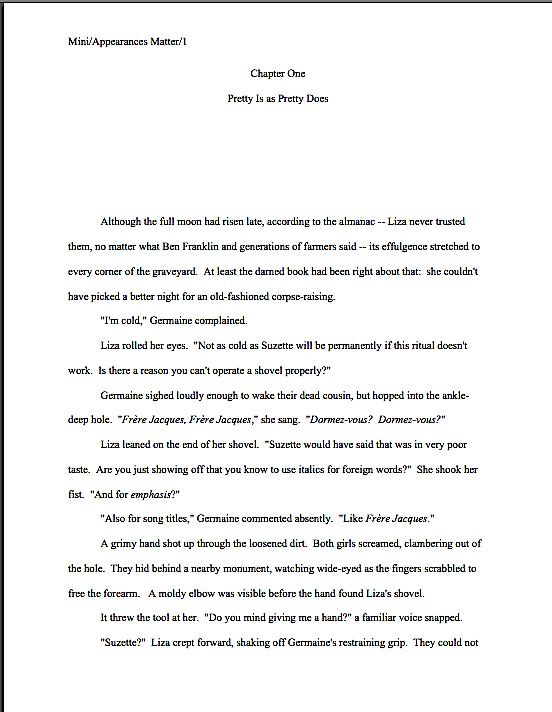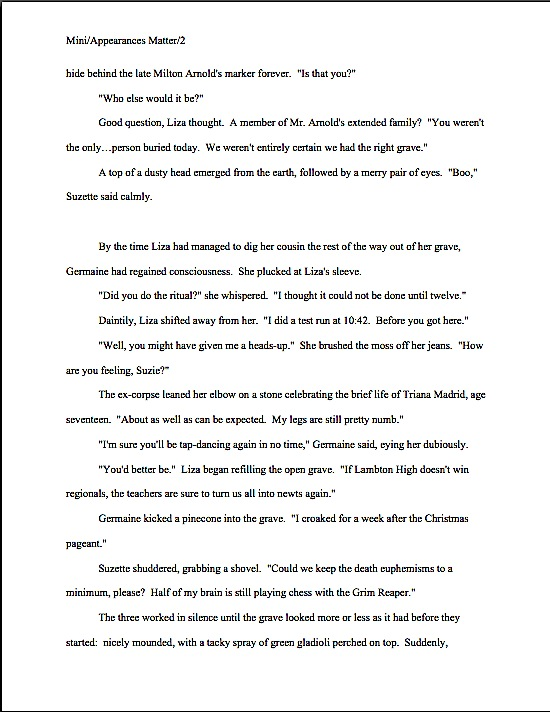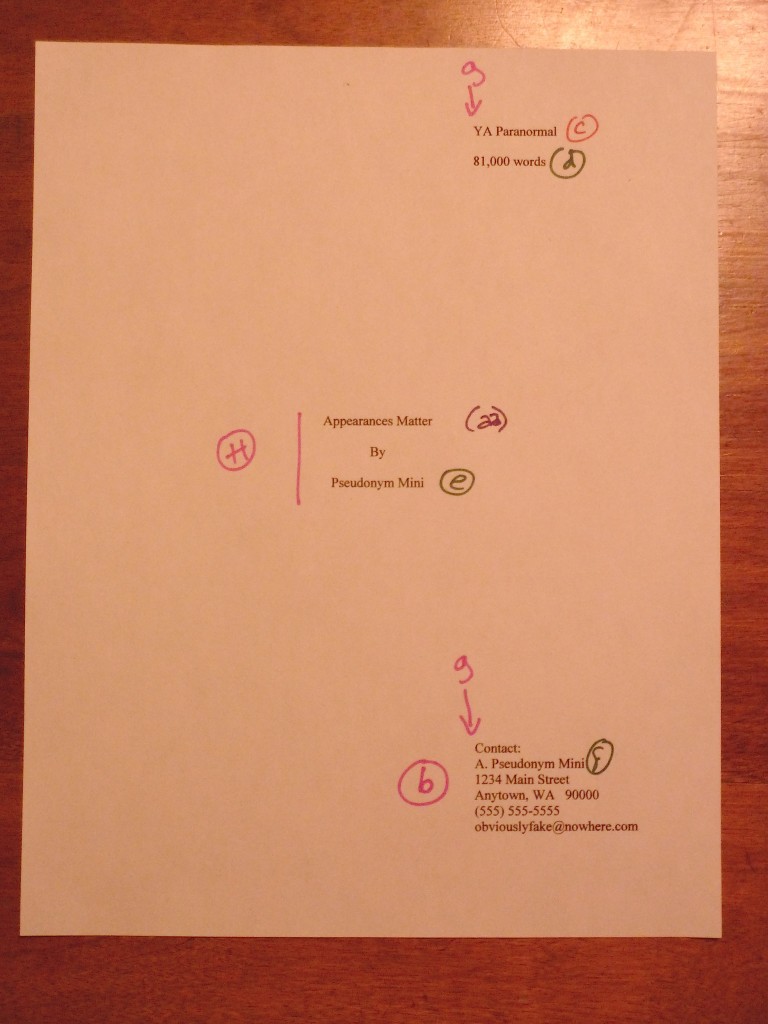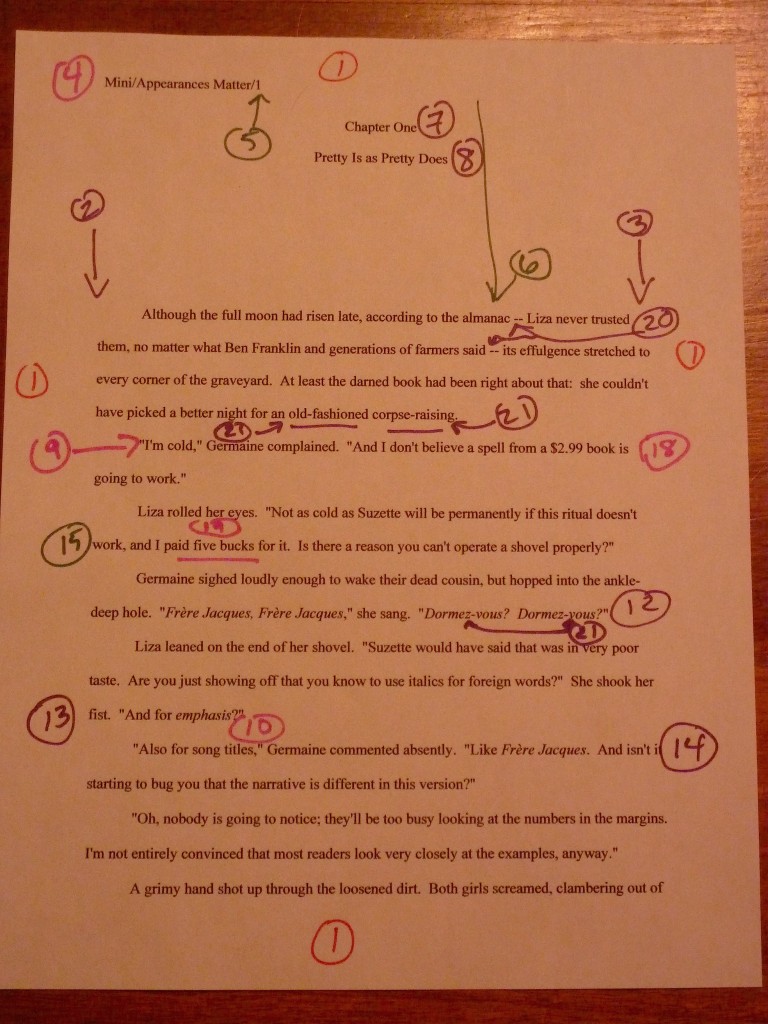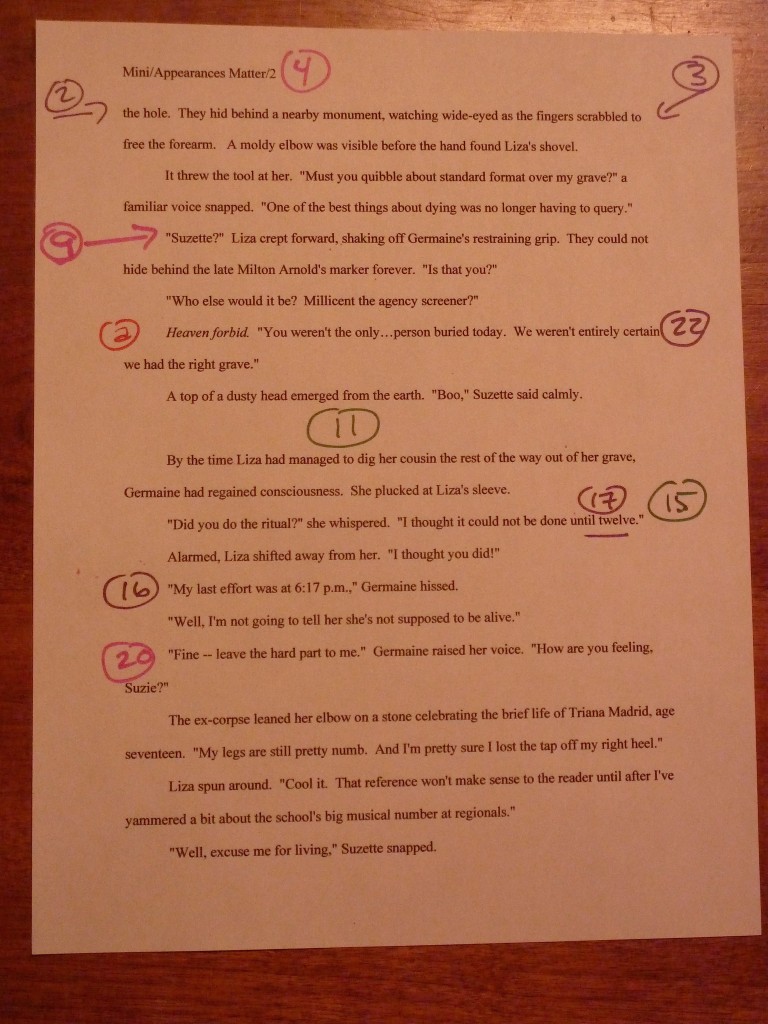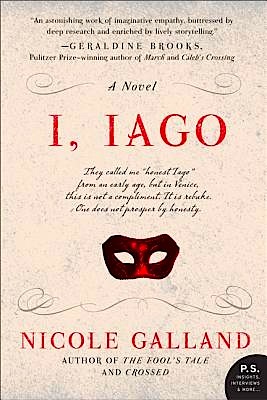I had intended to launch into the promised topic of cover letters for submissions over the weekend, campers, but I was inundated by quiet cries of distress. “But there’s so much to absorb!” post-pitch submitters have been moaning softly. “I had no idea that pulling my already-written manuscript together to submit to that nice agent/editor that requested it would be so complicated. How about giving us the weekend to catch up?”
Fair enough; I know that the strictures of standard format for book manuscripts is pretty hard to wrap one’s head around the first time one hears about it. That’s something those of us that read for a living are all to apt to forget, I’m afraid: until one has seen a few hundred professionally-formatted manuscripts up close and personal, there’s quite a lot about the process of putting one together that’s counterintuitive. If not downright insulting to a writer’s sense that if the writing is good enough, the presentation shouldn’t count.
If those of you planning to submit your work anytime soon have taken anything from this series, however, I sincerely hope it’s that to people in publishing, how a manuscript looks on the page is an indicator of a writer’s having done the necessary homework in order to work well with an agent or editor — and thus of that writer’s seriousness about becoming a professional author.
Speaking of counterintuitive, the vast majority of first-time submitters believe quite the opposite: that agents and editors will read a new writer’s manuscript with a kind eye, looking to like. Or so the pros surmise from the fact that so many submissions, even very good ones, contain non-standard formatting, misspelled words, grammatical mistakes, and other matters that would be hard for anyone that handled manuscripts for a living to overlook.
The result, I’m afraid, is all to often a failure to communicate. And that’s likely to be fatal, in a business devoted to communication.
I’m going to be talking later in the week about how to improve communication throughout the submission process. For today, however, we shall be concentrating upon a communication opportunity that submitters in general and post-pitch submitters in particular tend to skip entirely: the cover letter in the submission packet.
And already, the atmosphere is thick with huffs of derision. “Oh, please, Anne,” those of you on the cusp of submission murmur. “That agent to whom I pitched/queried asked to see my manuscript (or a portion thereof) knows it’s coming — thus the term requested materials. By definition, he knows who I am and what I write. So why on earth should I waste my time and his by writing a cover letter to explain something that requires no explanation ?”
Oh, I can think of plenty of reasons. Just off the top of my head: even if you send those page right after receiving the request, the agent or editor in question will not necessarily have you at the front of his mind; agents and editors at writers’ conferences frequently hear so many pitches that they begin to blur in retrospect; agents and editors often don’t open their own mail, and Millicent, their screener, has no reason to recognize your name; aspiring writers send unrequested submissions all the time, resulting in instant rejection.
Not including it is, in short, strategically unwise.
And at the risk of sounding like your mother, just slapping a manuscript into a box without any message of greeting is, let’s face it, rather rude. In an industry that actually does value manners to a charming, if old-fashioned, extent, I would strenuously advise anyone within the sound of my voice to avoid coming across as that.
Not sure why it might be considered rude? Well, think about it: even if you were expecting company, would you be comfortable opening your front door to someone that consistently refused to identify himself?
Unfortunately, a staggeringly high percentage of otherwise well-mannered submitters don’t think about that, apparently — and evidently do not give much thought to how much harder a submission sent sans cover letter would be to accept.
Frankly, the contents of the submission packet very often render it downright difficult for the agent to say yes if he likes the pages within. How so? Well, what’s the first thing he sees upon opening that box — or, more commonly, what his screener sees? Usually, something like this:
Or, should the submitter be somewhat better-versed in submission etiquette, something like this:
Not a lot to like there, eh? Just look at the poor paper quality: you can see page 1 vaguely outlined right through the title page.
Nor is that all. Not only does the sender evidently believe that the agent or editor that requested this asks to see so few manuscripts that hers would be instantly memorable — extremely unlikely — but she’s left Millicent to guess whether this is a requested or unsolicited submission.
Why is that not very wise? Unsolicited submissions almost always get rejected unread.
Still, the second example is better than the first. The sender of the first submission above has make herself almost impossible to sign as a client, at least without the recipient’s doing a good deal of record-searching that would not have been necessary if this writer had been more polite.
Not seeing why? Okay, let’s step into Millicent’s moccasins and take a closer look at the top page of the first submission box. You cut open what is probably your twentieth submission of the day to find this:
Did you study it carefully? If not with the scrutiny you wish the agent of your dreams would apply to your page 1, at least with respectful attention? (If you had too much trouble focusing on the details to do so, try holding down the COMMAND key and pressing + to enlarge the image.)
I hope you read it closely, because I have a couple of very serious questions to ask you, faux Millicent: who wrote this manuscript? And if your boss happens to like it, how will you get in touch with the writer in order to offer a representation contract?
The cover letter’s starting to seem like a better idea, isn’t it? If not, allow me to ask those of you still resisting the concept another serious question: if you were Millicent and had opened two submission boxes, one like our first example and one that contained a cover letter, which writer would you think would be less work for your boss to represent?
Shall I take the universal shudder that just went through my readership as an indication of understanding? “Okay, Anne,” those of you that sniffed at me a week ago when I urged you to include a title page with your submission, “I get it now: not placing my contact information at the top of my submission packet is a bad idea. But that’s not a problem if I include that title page you’ve been yammering about, is it? Since a good title page includes the writer’s contact information, why would the second submission example raise Millicent’s hackles at all?”
Good point, former title page-resisters. The short answer is that the overwhelming majority of title pages submitted do not include this information. They are merely decorative. Commonly, there’s a trade-off between what the writer perceives as beauty and Millicent is at all likely to consider either professional or informative. Like, for instance, this:
Colorful, yes; imaginative, certainly. But once again, it begs the question: how the heck would the requester of this manuscript get in touch with Cat in order to offer to represent her?
Trust me, the last response you want your submission to generate is a heart-felt, “Oh, it’s too bad we have no idea who sent us this or how to contact him or her; all we have is the author’s last name in the slug line. This saddens me, because I really liked this manuscript!”
As you say, though, a professionally-formatted title page would in fact provide any agent, editor, or Millicent with all the information necessary to contact the writer. The title page in our example, however, contains a red flag that might well convince any of the three just to ship the manuscript below it back unread. Take a closer look.
If you flung your hand into the air, leapt to your feet, and shouted, “Hey, that manuscript is well over the word count limit for its genre!” you get a gold star for the day. As we discussed last time, most agencies do have a target upper page limit in mind for first novels in a particular genre. That’s why, in case any of you had been wondering, agency submission guidelines often ask that a query letter should include a word count: so they can reject the over-long and the too-short without having to request the manuscript.
There’s another potential rejection reason here, however. Any guesses?
If you immediately screamed, “The book category listed does not exist,” help yourself to a second gold star out of petty cash. Aspiring writers do this all the time: believing that book category is primarily descriptive, rather than a quick reference to established marketing designations, they cram together mutually exclusive categories to form a hybrid.
Since that effort alone could have gotten this submission rejected, what should Cat have called this instead? Based on that first page, science fiction. And in her shoes, I would have either cut the manuscript in half and presented it as a series, or just left the word count off the title page.
Hey, agents do it all the time when submitting to editors; it honestly is extraordinarily difficult to sell a first-novel by a non-celebrity that’s much over 100,000 words. But you didn’t hear that from me.
Even if our friend Cat made both of these fundamental changes to her title page — after, perhaps, having checked to ascertain that using an estimated word count (250 words/page in Times New Roman x # of pages = a valid estimation) would not be less likely to engender instant rejection than the actual word count she seems to have used here — she would still be better off topping her submission with a nice, polite cover letter than merely relying upon the title page.
I hear some of you groaning. “Oh, come on. Haven’t I written enough for these people? The agent/editor has asked for my manuscript or a portion thereof; she’s also asked for a synopsis. And heaven knows I spent enough time writing my pitch and/or submission. Isn’t enough in fact enough?”
I sympathize with the submission fatigue, weary ones, but I think you’re overestimating the task at hand. In the first place, there’s no need for a long-winded missive — a simple thank-you to the agent for having asked to see the materials enclosed will do.
It’s hardly onerous. Seriously, for either a post-pitch or post-query submission, it could be as simple as the note penned by a colleague of Cat’s that’s done his homework, our old pal Literate McAuthorly.
Seriously, that’s all there is to it. Like any other thank-you letter, the courtesy lies more in the fact that the sender took the time to write it, rather than in what it actually says.
Still not convinced it’s worth your time to write? Okay, let’s move on to the second place: the submitter is the one who benefits from including a cover letter containing all of his contact information — all the more so because so few writers remember to tuck one into their packets, especially if they received the request for materials after a pitch. Suffice it to say that it’s in your best interest to assume that the person who heard your pitch or read your query won’t be the first person to screen your submission, for the exceedingly simple reason that it is, in practice, often a different human being.
Conveniently enough (and we’re up to the third place now, if you’re keeping track), the cover letter provides an excellent means of reminding the agent or editor that she did indeed request the pages enclosed. That minimizes the possibility that Millicent might slit open your submission packet and assume, wrongly, that it was just another unsolicited manuscript.
And we all know what happens to those, right? “Next!”
If the submission is the result of a conference pitch and Cat really wanted to be fancy about it — and believe me, you do — she could go ahead and say where you pitched the book to the agent. After a nice, long chat with her friend Literate, she might well come up with something like this:
See how easy it is for anyone who might open that box to contact Cat now? And see how little effort it took for her to establish herself from the get-go as a courteous, charming writer with whom it might be a pleasure to work?
It’s also apparent, I hope, just how close to effortless it would be to copy and paste this delightful little missive into an e-mail accompanying an electronic submission. The date and the agent’s address would be omitted, of course, but otherwise, it could go as is, with no further embellishment.
Do not, however, make the exceedingly common mistake of not including ALL of your contact information in an e-mailed submission. Writers do this all the time, assuming, with some justification, that all the agent would have to do is hit REPLY in order to get back to them. But electronic submissions sometimes get forwarded around agencies. Hitting REPLY, then, might well send a response to Millicent.
Besides, do you really want to limit the number of ways your future agent can contact you in order to offer you representation? Wouldn’t you be equally pleased with a positive phone call or letter as an e-mail?
Yes? You, with your hand in the air? “I can see that both Cat’s and Literate’s versions are polite, but I can’t help but notice that the formatting is different. And as someone who panics if I’m faced with more than one viable option, that distresses me!”
I’m afraid I can’t relieve your distress much, option-haters. Either format would be just fine: placing the sender’s contact information at the top or bottom of the page is equally permissible. Just don’t go over the top and do both.
What, your hand is still raised? Ask away, intrepid one. “But Anne, Cat’s met this agent face-to-face, right? Doesn’t that mean that she can call the agent by her unpronounceable first name?”
Well, she could, but it would be pushing the etiquette envelope a little. Unless a conference conversation extended beyond a pitch meeting to some social interaction, I would advise against becoming too familiar too soon. In an exchange with an agent or editor, it’s always safe to allow the pro to set the level of address intimacy.
What does that mean, in practice? Err on the side of formality in the cover letter; if the agent or editor addresses you as Dear Emile in a response, feel free to use first names from there on out.
Provided, of course, your name actually is Emile. If your name is Suzette, you might want to drop the agent a courteous, formal note, enclosing the missive to Emile and suggesting, gently, that your submission might have been confused with his.
Lordy, your hand is still up? “I’m still feeling a mite insecure, Anne. I would feel better if you gave me a list of what absolutely must be in my cover letter.”
A reasonable enough request. In fact, I’ll do even better: I’ll include some of the optional stuff, too. A cover letter with a submission should include:
(a) The writer’s full name
(b) All of the writer’s contact information
Not just some of it: your street address, telephone number, e-mail address should all be there, to render yourself as easy to contact as humanly possible.(c) The title of the book, just in case the letter and the manuscript end up on different desks. (Yes, it happens. Don’t ask; just prepare for the contingency.)
(d) What is actually enclosed
Mention the number of pages enclosed, if the agent or editor asked for a partial. If the request included other materials — like, say, a synopsis or an author bio — go ahead and bring ‘em up in the cover letter.Fringe benefit: if you are sending out more than one submission at a time (and you should, if you pitched successfully to more than one pro at a conference, unless one of them asked you for an exclusive), noting the contents of each packet in the cover letter will give you a record of what you sent to whom and when.
(e) The information that the manuscript enclosed was requested
(f) If you met the agent at a conference, mention that in the first paragraph of the letter, to help place your submission in context.
As crushing as it may be for the writerly ego to contemplate, an agent who spent days on end listening to hundreds of pitches probably is not going to remember each one. No need to re-pitch, of course, but a gentle reminder never hurts.While you’re at it, it’s not a bad idea to write the name of the conference on the outside of the envelope, along with REQUESTED MATERIALS. Heck, it’s a very good idea to write the conference’s name on the outside of a query to an agent one has heard speak at a conference, too, or to include the conference’s name in the subject line of a query e-mail. The point here is to render it pellucidly clear to the agent why you’re contacting her.
Do not, please, make the surprisingly common mistake of erring on the other side of caution, assuming that the requester didn’t really mean the request. You’d be astonished at how many successful pitchers send, instead of the pages the agent or editor asked to see, a query asking if the requester still wants to see the pages that — wait for it — the agent or editor asked to see.
Why would they double-check? Usually, because they don’t fully understand that a verbal pitch is a substitute for a query, not an additional hurdle. Sending a post-pitch query is totally unnecessary, a waste of everyone’s time, and sometimes even annoying enough that the request gets withdrawn. Just comply with the original request, okay?
(g) If another agent is already reading all or part of the manuscript you’re sending — or has asked to see it — mention this in your cover letter.
No need to say who it is or how long s/he has had it; just tell the recipient that s/he’s not the only one considering representing this book. It’s only polite. Unless the agency has a policy forbidding simultaneous submissions, withholding this information will only generate resentment down the line if more than one agent wants to represent your book.Yes, even if that agent to whom you submitted nine months ago has yet to respond. Actually, it’s in your strategic interest to contact that non-responder to let her know that another agent now has your manuscript.
One caveat: if you have heard with your very own personal ears the agent or editor say — at, for instance, the conference at which you pitched to him — that he doesn’t care whether anyone else is looking at a submission, go ahead and omit this information. Ditto if the requester has made this statement on his blog or the agency’s website.
You were intending to check these sources before you submitted, right, to make sure that the requester does not harbor any individual preferences? As always, if an agent or editor has been forthcoming enough to make a submission preference plain, honor it. It’s the polite thing to do.
It’s considerably less polite, though, to impose the non-standard preferences of another agent, editor, or some Yahoo given to spouting writing guidance online upon someone that has not expressed a desire to receive anything but a manuscript in standard format. This, too, is a small infraction of etiquette that well-meaning aspiring writers commit inadvertently all the time: since they’ve heard ONE agent say this or that — or, even more commonly, saw someone mention online that he heard that someone else heard an agent say this or that — they presume that this is the new rule, applicable to every other agent currently drawing breath.
Instead of trying to pretend that all agents share identical preferences — which a simple half-hour’s scroll through a random selection of agency websites would tell you was not true — a writer will always be better off treating those in a position to bring her book to publication as individuals. As, I suspect, you would like to be treated yourself: few aspiring writers, in my experience, relish feeling that Millicent will think of their work as generic.
Of course, you want your writing to stand out from the crowd. Another way to make your submission memorable: be the one submitter in fifty that includes a nice, polite, professional cover letter with your manuscript.
Your mother was right, you know: people really will like you better if you treat them with courtesy. Keep up the good work!








